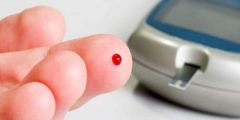Type 2 diabetes
Type 2 diabetes is considered a chronic, incurable disease, as it affects the way glucose is metabolized, which represents the primary source of energy in the body. In fact, this disease is represented by a high level of glucose in the blood as a result of cell resistance. For the work of insulin, or as a result of the lack of sufficient amounts of insulin in the blood, it should be noted that the hormone insulin plays an important role in regulating the process of glucose entering the cells, thus maintaining the sugar level within normal levels in the blood, and type XNUMX diabetes is usually known as, Non-insulin dependent diabetes, or adult-onset diabetes.
Causes of type 2 diabetes
At the beginning of the disease, the pancreas produces the hormone insulin in large quantities, until it loses the ability to produce sufficient quantities to keep sugar within its normal levels, so its level in the blood rises. Among the most important underlying causes of type 2 diabetes are the following:
- genes: Some genetic genes affect how insulin is produced in the body.
- Overweight: Excess weight, especially fat accumulated around the waist, contributes to cell resistance to insulin.
- Metabolic syndrome: (in English: Metabolic syndrome) In this case, some individuals with insulin resistance suffer from other problems, including high blood sugar, high blood pressure, high cholesterol, high triglycerides, and fat accumulation in the waist circumference.
- Increased sugar production: The liver manufactures sugar if its quantities are less than the normal rate, and stops doing so after eating and the sugar entering the blood. However, the liver may continue to manufacture sugar in some people despite its availability in the blood.
- Poor communication between cells: The transmission of signals between cells responsible for producing and consuming glucose or insulin occurs in an incorrect manner, leading to high blood sugar.
- Beta cell damage: It is represented by the presence of a defect in these cells that affects the production of insulin and the time of its exit from the pancreas. Also, these cells may be harmed due to high blood sugar.
Read also:Harmful effects of high blood sugar
Symptoms of type 2 diabetes
Symptoms of type 2 diabetes appear relatively slowly, and include the following symptoms:
- Extreme thirst: High blood sugar causes water to be withdrawn from the tissues, thus making you feel the need to drink water.
- frequent urination: The need to urinate increases as a result of increased water intake.
- Extreme hunger: Failure of sugar to enter the cells, muscles, and various organs leads to a loss of energy, and thus a feeling of hunger.
- Weight loss: Weight decreases as a result of the body's inability to consume the sugar present in the blood, so it resorts to consuming the energy stored in muscles and fat, thereby losing calories and weight, and the body gets rid of excess sugar with urine.
- Tired: Cells not getting the sugar they need leads to fatigue and irritability.
- Lack of vision: Fluid is drawn from the lens of the eye due to the accumulation of sugar in the blood.
- Difficulty healing sores: A diabetic patient's resistance to infection decreases, and the disease affects the speed of healing of wounds and ulcers.
- Skin discolouration: Dark spots appear in some folds and creases of the skin, such as the armpits and neck, and these spots indicate the presence of insulin resistance.
Factors causing type 2 diabetes
There are a group of factors that increase the possibility of developing type 2 diabetes, the most important of which are:
Read also:Harmful effects of high blood sugar- Overweight and obesity.
- Accumulation of fat in the abdomen.
- Lack of physical activity.
- smoking.
- Stress and tension.
- Lack of sleep or too much sleep.
- Having a family history of the disease.
- aging
- Gestational diabetes.
- Having polycystic ovary syndrome.
Diagnosis of type 2 diabetes
The doctor performs a blood sugar level test, and the disease is diagnosed if the test result is very high, or the high test result is accompanied by many signs and symptoms appearing on the patient. The doctor may request that this test be repeated to confirm the diagnosis of the disease, and one of the most important laboratory tests used is In diagnosing type 2 diabetes:
- Cumulative blood sugar test: The cumulative sugar test aims to know the blood sugar level during the previous two or three months, and this test is known as the A1C test for short.
- Fasting glucose test: The fasting plasma glucose test aims to measure the blood sugar level, after abstaining from eating and drinking, except for water, for eight hours.
- Glucose tolerance test: The oral glucose tolerance test aims to find out how the body deals with sugar, by checking the sugar level before and after drinking a sweetened drink designated for testing.
Read also:When is blood sugar low?
Treatment of type 2 diabetes
Treatment for type 2 diabetes begins with changing the lifestyle followed to a healthy one. If these changes do not provide the desired benefit, doctors resort to using medications.
Treatment by changing lifestyle
Normal blood sugar levels can be maintained through the following preventive and therapeutic measures:
- Eat healthy food: The patient is advised to eat a healthy, balanced diet rich in dietary fiber, fruits, and vegetables, and low in fat.
- Losing excess weight: The patient is advised to get rid of excess weight as much as possible, to reduce blood sugar levels, and to ensure overall body health.
- Exercising Regular exercise helps reduce blood sugar levels, and also helps reduce the risk of heart attacks and strokes. Examples of such exercises include: brisk walking, swimming, cycling, and dancing, for 30 minutes a day, for an average of five days a day. Week, and exercises can be divided throughout the day.
drug therapy
A patient with type 2 diabetes may not be satisfied with lifestyle changes to control blood sugar levels, and needs to use therapeutic medications to maintain blood sugar within the normal range and to avoid complications of diabetes. Pills are considered the most common pharmaceutical form used to treat type 2 diabetes. Metformin is perhaps one of the most prominent examples of oral treatments, and injections represent the other pharmaceutical form available to treat diabetes, and one of the most important examples of therapeutic injections for diabetics is insulin injections.









